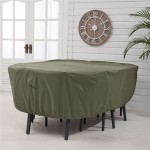How To Keep Bugs Off Patio Furniture: A Comprehensive Guide
Enjoying outdoor spaces, particularly a patio, is a common desire, especially during warmer months. However, the presence of insects can significantly detract from the experience. Protecting patio furniture from bugs requires a multi-faceted approach, addressing both prevention and treatment strategies. This article provides a detailed guide on how to effectively manage and minimize insect activity around patio furniture.
Understanding Common Patio Pests
Before implementing control measures, it is crucial to identify the types of insects commonly found in patio areas. Common culprits include mosquitoes, flies, ants, spiders, aphids, and beetles. Each type of pest exhibits unique behaviors and preferences, necessitating tailored control methods.
Mosquitoes are attracted to standing water, carbon dioxide, and body heat. They are known for their irritating bites and potential to transmit diseases. Flies, on the other hand, are drawn to decaying organic matter and food sources. They can contaminate surfaces and spread bacteria.
Ants often forage for food crumbs and sugary substances, establishing trails to and from patio furniture. Spiders are typically drawn to areas with ample prey, like other insects, and may build webs on or around furniture. Aphids, small sap-sucking insects, can infest plants near the patio and subsequently migrate to furniture, leaving behind sticky honeydew.
Certain types of beetles may also be attracted to patio furniture, particularly wooden furniture, where they may bore into the material. Identifying the specific pest is critical for selecting the most effective control methods.
Preventative Measures: Creating a Bug-Unfriendly Environment
The most effective approach to managing patio pests is prevention. By implementing strategies to deter insects before they become a problem, individuals can minimize the need for reactive treatments. Several preventative measures can be taken to make the patio area less attractive to bugs.
Maintaining cleanliness is paramount. Regularly sweep or hose down the patio surface to remove crumbs, spilled food, and debris. Wipe down patio furniture after use to eliminate food residue. Empty trash cans frequently and ensure they have tightly fitting lids to prevent odors from attracting flies and other insects.
Eliminating standing water is crucial for mosquito control. Regularly empty flower pots, bird baths, and other containers that may collect water. Ensure proper drainage around the patio area to prevent water from pooling. Consider using mosquito dunks or larvicides in areas where standing water cannot be eliminated entirely; these products contain bacteria that target mosquito larvae.
Strategic landscaping can also deter pests. Certain plants, such as citronella, marigolds, lavender, and mint, are known to repel insects. Planting these around the patio perimeter can create a natural barrier. Conversely, avoid planting flowering plants that attract bees and wasps near seating areas.
Lighting choices can impact insect activity. Replace traditional incandescent bulbs with yellow or LED bulbs, which are less attractive to many insects. Consider using bug zappers or outdoor lanterns with insect repellent cartridges, but exercise caution as bug zappers can indiscriminately kill beneficial insects as well.
Proper furniture maintenance can deter certain pests. For wooden furniture, apply a sealant or stain to protect the wood from moisture and prevent insects from boring into it. Regularly inspect furniture for signs of damage or infestation, such as small holes or sawdust-like residue.
Treatment Options: Addressing Existing Pest Problems
When preventative measures are insufficient, or an existing pest problem needs addressing, various treatment options are available. The choice of treatment should be based on the type of pest, the severity of the infestation, and personal preferences regarding chemical versus natural solutions.
Insecticidal sprays can be effective for controlling a wide range of pests. Choose a product specifically labeled for outdoor use and follow the manufacturer's instructions carefully. Apply the spray to patio furniture, paying particular attention to cracks and crevices where insects may hide. Be mindful of potential impacts on beneficial insects and pets when using chemical sprays.
Natural insect repellents offer an alternative to chemical insecticides. Products containing essential oils, such as citronella, eucalyptus, peppermint, and cedarwood, can repel mosquitoes and other insects. Apply these repellents to patio furniture or use diffusers to disperse the scent throughout the area. Essential oil-based repellents typically require more frequent application than chemical sprays.
Insecticidal soaps can be effective against aphids, spider mites, and other soft-bodied insects. Apply the soap directly to the affected plants and furniture, ensuring thorough coverage. Insecticidal soaps work by disrupting the insect's cell membranes, causing dehydration and death.
Diatomaceous earth (DE) is a natural powder made from fossilized diatoms. It is effective against ants, fleas, and other crawling insects. Sprinkle DE around the perimeter of the patio and on furniture legs. DE works by damaging the insect's exoskeleton, causing dehydration. Use food-grade DE for safety and avoid inhaling the powder.
Traps can be used to capture specific types of insects. Fly traps, mosquito traps, and ant bait stations can help reduce pest populations. Place traps strategically in areas where insects are commonly observed. Regularly check and empty traps to maintain their effectiveness.
For severe infestations, professional pest control services may be necessary. Pest control professionals have access to specialized equipment and insecticides that are not available to the general public. They can also identify the source of the infestation and implement long-term control strategies.
Maintaining a Pest-Free Patio
Keeping a patio bug-free is an ongoing process that requires vigilance and consistent effort. Regular inspection of the patio area and furniture is essential for detecting early signs of infestation. By combining preventative measures with targeted treatments, individuals can create a comfortable and enjoyable outdoor space free from unwanted pests.
Periodically clean and inspect patio furniture, particularly after periods of non-use or inclement weather. Check for webs, nests, or signs of insect activity. Address any issues promptly to prevent infestations from escalating.
Regularly maintain landscaping around the patio area. Prune shrubs and trees to improve air circulation and reduce harborage for insects. Remove fallen leaves and debris that can provide a breeding ground for pests.
Monitor the effectiveness of implemented control measures. If certain treatments are not providing adequate results, consider trying alternative methods or consulting with a pest control professional.
Adjust control strategies based on seasonal changes. Insect activity may fluctuate throughout the year, requiring adjustments to preventative and treatment measures. For example, mosquito control may be more critical during the summer months, while ant control may be more important during the spring.
By implementing these strategies, individuals can minimize the presence of insects on patio furniture and enjoy their outdoor spaces without the annoyance and potential health risks associated with pests.

How To Keep Bugs Off Your Patio Turf Factory

How To Keep Bugs Off Your Patio Furniture Blue Lagoon Spas

Some Tips For Answering How To Keep Bugs Off Patio Furniture Q

How To Keep Bugs Off Your Patio Turf Factory

Some Tips For Answering How To Keep Bugs Off Patio Furniture Q

13 Simple Ways To Keep Spiders Away From Your Patio Wikihow

Some Tips For Answering How To Keep Bugs Off Patio Furniture Q

How To Keep Bugs Away From Your Patio Neighbor

Create A Pest Free Zone On Your Patio And Deck

What You Can Do To Keep Bugs Away From Patio Furniture
See Also








